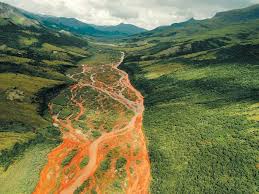For years, scientists have been puzzled by the sudden and dramatic color change of rivers and streams across Alaska. Once crystal clear, these waters have turned a striking shade of orange. Recent research attributes this phenomenon to climate change, specifically the thawing of permafrost which is releasing minerals into the water. This discovery has significant implications for the environment, particularly for drinking water and local fisheries.
The Mystery of Alaska’s Orange Rivers
dentifying the Cause
Thawing Permafrost
Permafrost, or permanently frozen ground, is a common feature in Alaska. As global temperatures rise, permafrost is thawing, releasing previously trapped minerals into rivers and streams. This influx of minerals is believed to be responsible for the orange discoloration.
Mineral Composition
The specific minerals released include iron and other elements that, when oxidized, give the water its rusty hue. This process is akin to the rusting of iron when exposed to air and moisture, creating a visually dramatic change in the landscape.
Areas Affected
Gates of the Arctic and Kobuk Valley
The orange waters have been observed in several locations, particularly within federal lands such as the Gates of the Arctic and Kobuk Valley national parks. These areas are known for their pristine natural environments, making the color change even more striking.
Remote Sampling Locations
Researchers have collected samples from 75 locations across northern Alaska’s Brooks Mountain Range. Many of these sites are so remote that they can only be accessed by helicopter, underscoring the vast and challenging terrain scientists are studying.
Environmental Impact
Threats to Drinking Water
Potential Toxicity
The mineral-rich waters could pose risks to local drinking water supplies. Elevated levels of certain minerals can be toxic, potentially making the water unsafe for human consumption without extensive treatment.
Monitoring and Mitigation
Scientists and local authorities are closely monitoring the situation. Mitigation efforts may be necessary to ensure that communities have access to safe drinking water, highlighting the intersection of environmental changes and public health.
Effects on Fisheries
Fish Migration and Spawning
One of the most concerning impacts is on local fish populations. The orange streams may prevent fish from migrating to their spawning areas, disrupting their life cycles and threatening the sustainability of these populations.
Ecological Balance
The disruption of fish migration can have cascading effects on the broader ecosystem. Predatory species and other wildlife that depend on fish as a food source could also be affected, altering the ecological balance in these regions.
Scientific Research and Findings
The Study in Nature Earth and Environment
Research Methodology
The findings about Alaska’s orange rivers were published in the journal Nature Earth and Environment. The study involved extensive fieldwork and analysis, combining on-the-ground sampling with advanced laboratory techniques to identify the mineral composition and its sources.
Key Conclusions
The research concluded that the thawing of permafrost due to climate change is the primary driver of the color change. This process is expected to continue as global temperatures rise, potentially affecting more areas and exacerbating the current issues.
Implications for Future Research
Long-Term Monitoring
Ongoing monitoring is crucial to understanding the long-term impacts of these changes. Researchers aim to track the progression of mineral release and its effects on the environment over time.
Broader Climate Change Indicators
The phenomenon of orange rivers is a stark indicator of the broader impacts of climate change. It underscores the need for comprehensive climate action to address and mitigate the multifaceted consequences of a warming planet.
The Broader Climate Change Context
Global Warming and Permafrost Thawing
Rising Temperatures
Global warming is leading to increased temperatures worldwide, with the Arctic region experiencing some of the most rapid changes. Thawing permafrost is a direct result of these temperature increases, releasing not only minerals but also greenhouse gases like methane.
Feedback Loops
The release of greenhouse gases from thawing permafrost creates a feedback loop, where increased emissions further accelerate global warming, leading to more permafrost thawing. This cycle presents significant challenges for climate scientists and policymakers.
Impact on Indigenous Communities
Cultural and Economic Effects
Indigenous communities in Alaska are particularly vulnerable to the effects of climate change. Changes in water quality and fish populations directly impact their traditional ways of life and economic activities, such as fishing and hunting.
Adaptation Strategies
These communities are developing adaptation strategies to cope with the changing environment. This includes finding new sources of drinking water and adjusting fishing practices to account for altered fish migration patterns.
The transformation of Alaska’s rivers and streams into vibrant orange waterways is a vivid example of the far-reaching impacts of climate change. Thawing permafrost releasing minerals into these waters poses significant threats to drinking water safety and the health of local fisheries. As scientists continue to study and monitor these changes, it becomes increasingly clear that comprehensive climate action is necessary to address and mitigate these challenges. The phenomenon serves as a reminder of the interconnectedness of our ecosystems and the urgent need to protect them.




